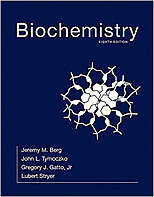
Biochemistry
Berg, Jeremy M.; Tymoczko, John L.; Gatto, Jr., Gregory J.; Stryer, Lubert
8 ed.
New York: W.H. Freeman and Company, 2015
 |
Biochemistry Berg, Jeremy M.; Tymoczko, John L.; Gatto, Jr., Gregory J.; Stryer, Lubert 8 ed. New York: W.H. Freeman and Company, 2015 |
78 termes
| S value n. |
|
| S1 n. |
|
| S1 pocket n. |
|
| S2 n. |
|
| Saccharomyces cerevisiae [nom cientÝfic] |
|
| Salmonella test n. |
|
| Sample half-cell n. |
|
| SAR n. (structure-activity relationship) |
|
| sarcoplasmic reticulum Ca2+ ATPase n. (SERCA) |
|
| Schiff base intermediate n. |
|
| Schiff-base linkage n. |
|
| screw sense n. |
|
| SDS-polyacrylamide gel electrophoresis n. |
|
| secondary active transport n. |
|
| secondary antibody n. |
|
| secretory pathway n. |
|
| selective permeability n. |
|
| self-assembly process n. |
|
| self-sealing adj. |
|
| semiconservative replication n. |
|
| sensory connection n. |
|
| separable subunit n. |
|
| sequence-comparison method n. |
|
| SERCA n. (sarcoplasmic reticulum Ca2+ ATPase) |
|
| serine hydroxymethyltransferase n. |
|
| serine protease inhibitor n. |
|
| serine residue n. |
|
| seven-transmembrane-helix receptor n. (7TM receptor) |
|
| shape complementarity n. |
|
| sheetlike structure n. |
|
| shuffled sequence n. |
|
| sigmoid binding curve n. |
|
| sigmoidal curve n. |
|
| single molecule study n. |
|
| single-carbon compound n. |
|
| single-stranded-binding protein n. (SSB) |
|
| sliding-filament model n. |
|
| slow enzyme n. |
|
| small interference RNA n. (siRNA) |
|
| small regulatory RNA n. |
|
| SOCS n. (suppressor of cytokine signaling) |
|
| SOD1 gene n. |
|
| solid-phase peptide synthesis n. |
|
| solid-phase synthesis n. |
|
| Sos n. |
|
| specificity constant n. (kcat/KM) |
|
| spectroscopic characteristic n. |
|
| Src homology 2 domain n. (SH2 domain) |
|
| Src homology 3 domain n. (SH3 domain) |
|
| SRE n. (sterol regulatory element) |
|
| stable radical n. |
|
| stacked region n. |
|
| stacking force n. |
|
| standard reference half-cell n. |
|
| start site n. |
|
| steady-state assumption n. |
|
| stearoyl CoA desaturase n. |
|
| stereoelectronic effect n. |
|
| steroid-hormone receptor n. |
|
| strand invasion n. |
|
| Streptomyces coelicolor [nom cientÝfic] |
|
| Streptomyces lividans [nom cientÝfic] |
|
| stroma lamellae n. |
|
| strong promoter n. |
|
| structural scaffolding n. |
|
| subfamily A1 n. |
|
| substituted enzyme intermediate n. |
|
| substrate concentration n. |
|
| sucrose 6-phosphate n. |
|
| sulfhydryl group n. |
|
| super compensation n. (carbo-loading) |
|
| superhelical cable n. |
|
| superoxide radical n. |
|
| suppressor of cytokine signaling n. (SOCS) |
|
| sweet receptor n. |
|
| switch I n. |
|
| switch II n. |
|
| synthetic analog model system n. |
|